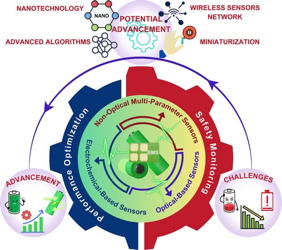Home > Press > Sensors innovations for smart lithium-based batteries: advancements, opportunities, and potential challenges
 |
| Sensors for smart Lithium-based batteries (LiBs) are classified based on their application into safety monitoring (i.e., temperature, pressure, and strain) to detect hazardous conditions and performance optimization (i.e., optical and electrochemical sensors) for monitoring factors such as state of charge and state of health.
The potential for innovation in LiB sensor technology is driven by advancements in nanotechnology, miniaturization, machine learning algorithms, and wireless sensor networks, all of which contribute to enhanced sensor performance. Key challenges faced in developing LiB sensors include miniaturization, power consumption, cost efficiency and scalability, and compatibility with existing battery management systems. Credit amile Mohammadi Moradian, Amjad Ali, Xuehua Yan, Gang Pei, Shu Zhang, Ahmad Naveed, Khurram Shehzad, Zohreh Shahnavaz, Farooq Ahmad, Balal Yousaf. |
Abstract:
Lithium-ion batteries (LiBs) are the beating heart of the electric vehicle (EV) revolution, renewable energy storage, and portable electronics. Yet, their safety risksthermal runaway, gas venting, catastrophic failureremain a critical bottleneck. Now, a comprehensive review led by Shu Zhang (Nanjing Forestry University) , published in Nano-Micro Letters, unveils how advanced sensor technologies are transforming LiBs into smart, self-aware energy systems.
Sensors innovations for smart lithium-based batteries: advancements, opportunities, and potential challenges
Shanghai, China | Posted on August 8th, 2025
Why Smart Sensors Matter
Real-time Safety Monitoring: From temperature spikes to gas leaks, sensors act as an early warning system, preventing thermal runaway before it starts.
Performance Optimization: By tracking state-of-charge (SoC) and state-of-health (SoH), sensors enable precise battery management, extending lifespan and efficiency.
In-situ Diagnostics: Embedded sensors reveal hidden degradation mechanismslike lithium plating or electrolyte breakdownwithout dismantling the battery.
Cutting-edge Sensor Strategies
Fiber Bragg Grating (FBG) Sensors: These hair-thin optical fibers detect micro-strain and temperature changes inside cells, offering sub-millimeter precision without electromagnetic interference.
Gas Sensors for Thermal Runaway: Chemiresistive and amperometric sensors detect H2, CO2, and volatile organic compounds (VOCs) at ppm levels, providing ~600 seconds of early warning before fire/explosion events.
MEMS-Integrated Microsensors: Miniaturized temperature-pressure sensors embedded in 18650 cells monitor jelly-roll expansion, correlating mechanical stress with capacity fade.
Detection & AI Integration
Ultrasonic & Acoustic Emission: Detect electrode cracking and gas formation via sound waves, achieving Machine Learning Fusion: Random forest and LSTM models analyze multi-sensor data (voltage, strain, gas) to predict remaining useful life (RUL) with Blockchain-Enabled IoT: Wireless sensor networks (WSNs) paired with blockchain secure real-time battery data for EV fleets and grid storage.
Future Outlook
Self-healing Sensors: Dynamic polymer nanocomposites recover from mechanical damage, ensuring 90% conductivity after thermal cycling.
Sustainability: Recyclable nanocellulose-based sensors reduce environmental impact, aligning with EU battery regulations (2027).
AI-BMS Synergy: Physics-informed neural networks (PINNs) will couple sensor data with electrochemical models for zero-latency fault detection.
Smart sensors are redefining lithium-ion batteries from passive energy stores to intelligent, self-protecting systems. Stay tuned for breakthroughs from the Jiangsu-Nankai sensor consortium!
####
For more information, please click here
Contacts:
Bowen Li
Shanghai Jiao Tong University Journal Center
Office: 021-62800059
Copyright © Shanghai Jiao Tong University Journal Center
If you have a comment, please Contact us.
Issuers of news releases, not 7th Wave, Inc. or Nanotechnology Now, are solely responsible for the accuracy of the content.
News and information
![]()
Deciphering local microstrain-induced optimization of asymmetric Fe single atomic sites for efficient oxygen reduction August 8th, 2025
![]()
Lab to industry: InSe wafer-scale breakthrough for future electronics August 8th, 2025
![]()
New imaging approach transforms study of bacterial biofilms August 8th, 2025
Possible Futures
![]()
ICFO researchers overcome long-standing bottleneck in single photon detection with twisted 2D materials August 8th, 2025
![]()
New molecular technology targets tumors and simultaneously silences two undruggable cancer genes August 8th, 2025
![]()
Simple algorithm paired with standard imaging tool could predict failure in lithium metal batteries August 8th, 2025
![]()
First real-time observation of two-dimensional melting process: Researchers at Mainz University unveil new insights into magnetic vortex structures August 8th, 2025
Sensors
![]()
Quantum engineers squeeze laser frequency combs to make more sensitive gas sensors January 17th, 2025
![]()
Nanofibrous metal oxide semiconductor for sensory face November 8th, 2024
Announcements
![]()
Deciphering local microstrain-induced optimization of asymmetric Fe single atomic sites for efficient oxygen reduction August 8th, 2025
![]()
Japan launches fully domestically produced quantum computer: Expo visitors to experience quantum computing firsthand August 8th, 2025
![]()
ICFO researchers overcome long-standing bottleneck in single photon detection with twisted 2D materials August 8th, 2025
![]()
New molecular technology targets tumors and simultaneously silences two undruggable cancer genes August 8th, 2025
Interviews/Book Reviews/Essays/Reports/Podcasts/Journals/White papers/Posters
![]()
New molecular technology targets tumors and simultaneously silences two undruggable cancer genes August 8th, 2025
![]()
Simple algorithm paired with standard imaging tool could predict failure in lithium metal batteries August 8th, 2025
![]()
First real-time observation of two-dimensional melting process: Researchers at Mainz University unveil new insights into magnetic vortex structures August 8th, 2025
![]()
Lab to industry: InSe wafer-scale breakthrough for future electronics August 8th, 2025
Energy
![]()
Simple algorithm paired with standard imaging tool could predict failure in lithium metal batteries August 8th, 2025
![]()
KAIST researchers introduce new and improved, next-generation perovskite solar cell November 8th, 2024
![]()
Groundbreaking precision in single-molecule optoelectronics August 16th, 2024
Automotive/Transportation
![]()
Simple algorithm paired with standard imaging tool could predict failure in lithium metal batteries August 8th, 2025
![]()
Leading the charge to better batteries February 28th, 2025
Battery Technology/Capacitors/Generators/Piezoelectrics/Thermoelectrics/Energy storage
![]()
Deciphering local microstrain-induced optimization of asymmetric Fe single atomic sites for efficient oxygen reduction August 8th, 2025
![]()
Simple algorithm paired with standard imaging tool could predict failure in lithium metal batteries August 8th, 2025
![]()
Enhancing power factor of p- and n-type single-walled carbon nanotubes April 25th, 2025










